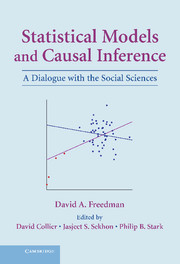Book contents
- Frontmatter
- Contents
- Preface
- Editors' Introduction: Inference and Shoe Leather
- Part I Statistical Modeling: Foundations and Limitations
- Part II Studies in Political Science, Public Policy, and Epidemiology
- Part III New Developments: Progress or Regress?
- Part IV Shoe Leather Revisited
- References and Further Reading
- Index
Editors' Introduction: Inference and Shoe Leather
Published online by Cambridge University Press: 05 June 2012
- Frontmatter
- Contents
- Preface
- Editors' Introduction: Inference and Shoe Leather
- Part I Statistical Modeling: Foundations and Limitations
- Part II Studies in Political Science, Public Policy, and Epidemiology
- Part III New Developments: Progress or Regress?
- Part IV Shoe Leather Revisited
- References and Further Reading
- Index
Summary
Drawing sound causal inferences from observational data is a central goal in social science. How to do so is controversial. Technical approaches based on statistical models—graphical models, non-parametric structural equation models, instrumental variable estimators, hierarchical Bayesian models, etc.—are proliferating. But David Freedman has long argued that these methods are not reliable. He demonstrated repeatedly that it can be better to rely on subject-matter expertise and to exploit natural variation to mitigate confounding and rule out competing explanations.
When Freedman first enunciated this position decades ago, many were skeptical. They found it hard to believe that a probabilist and mathematical statistician of his stature would favor “low-tech” approaches. But the tide is turning. An increasing number of social scientists now agree that statistical technique cannot substitute for good research design and subject-matter knowledge. This view is particularly common among those who understand the mathematics and have on-the-ground experience.
Historically, “shoe-leather epidemiology” is epitomized by intensive, door-to-door canvassing that wears out investigators' shoes. In contrast, advocates of statistical modeling sometimes claim that their methods can salvage poor research design or low-quality data. Some suggest that their algorithms are general-purpose inference engines: Put in data, turn the crank, out come quantitative causal relationships, no knowledge of the subject required.
This is tantamount to pulling a rabbit from a hat. Freedman's conservation of rabbits principle says “to pull a rabbit from a hat, a rabbit must first be placed in the hat.” In statistical modeling, assumptions put the rabbit in the hat.
- Type
- Chapter
- Information
- Statistical Models and Causal InferenceA Dialogue with the Social Sciences, pp. xiii - xviPublisher: Cambridge University PressPrint publication year: 2009
- 2
- Cited by

